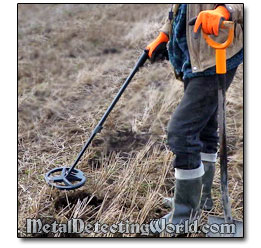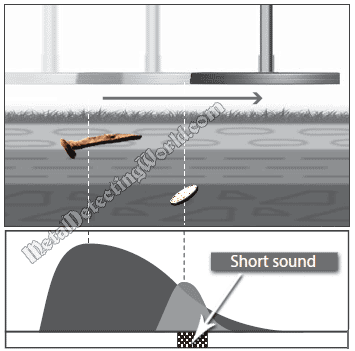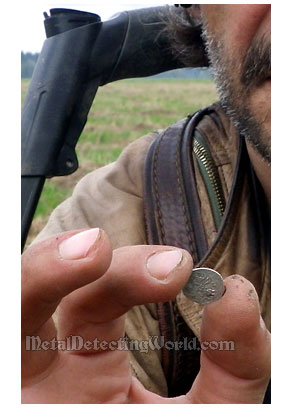PART II: Metal Detecting Tips for XP Deus Users - Search Coil Wiggling Technique, page 2
Use Search Coil Wiggling Technique To Decipher Ambiguous Signals of Coin+Nail Type
(...CONTINUED from Previous Page)

"Good Signal Fishing" - XP Deus Search Coil Wiggling Technique
After you move the search coil back over the signal spot, "hook" the signal so that you can hear it with every sweep of the coil. Now, the signal must be "reeled in to shore" by approaching a target spot with the search coil from different directions and using very short spans (no wider than 5 inches (10 cm)) - wiggling, of the coil.
As soon as you "scoop the signal up with your net" - you isolate the high-tone signal - this will be indicated by getting the best audio response, the signal becomes "two-way" repeatable and without iron buzz. And the target's VDI value will be consistent within a range of non-ferrous valuable targets. In reality, this whole procedure takes less than 30 seconds.
NOTE 1: This same coil wiggling technique is used to isolate clear "one-way" and "two-way" repeatable responses of high-pitched tones.
NOTE 2: The coil wiggling technique is only effective with a stock 9-inch search coil. A larger coil (11-inch or 13" x 11") may not be able to isolate a good signal from a bad one in most cases because the large coil may simultaneously detect both a target in focus and other targets nearby.
If the iron buzz does not disappear, you may try to fast-switch to your preset program (see my article "Advantages in Fast-Switching Between XP Deus' Search Programs") that has a higher setting of Reactivity. If that does not help in isolating the high-pitched signal, and the VDI numbers remain mostly in the iron range (from 01 to 10), you have most likely encountered an iron target that has induced an audio response of an Iron-Falsing type (described on next page).
NOTE 3: It is important to pay close attention to a volume level of the iron buzz during the above-mentioned process. If you simultaneously hear both a good "two-way" response of a high-pitched tone and a BARELY sounding iron buzz (as if in the background), it could be an unmasked coin positioned above an iron nail. This signal should be investigated further - dig the target up!
The iron buzz may not disappear in a case when a coin is too small (like a small and thin-sectioned hammered coin) for the Reactivity setting to separate the coin's high-pitched tone from the iron buzz, as shown on a picture below, and even allow the coin to induce a clear audio response when being unmasked.

Case of a Coin Partially Masked by Nail

In this case, only the "good signal fishing" technique (described above) can help. By wiggling the search coil at a small angle to the ground surface ("Coil-Tilting" technique) while approaching a target spot with the coil from different directions, you will be able to "hook" and "fish out" a better audio response to the coin. The response would not become "two-way" repeatable but, at least, a little bit wider. To improve the audio response even more, you may want to fast-switch to your preset search program which employs less Conventional Discrimination.
Now comes the hardest part of this process: you need to "call to arms" all your hearing to make a good judgment of how much of the high-tone signal is mixed with the iron buzz. Theoretically a "70% to 30%" proportion between the high tone and low tone respectively in the mixed signal should be a good reason for digging the target up. It will not be easy for you to evaluate the mixed signals correctly right off the start. But after you investigate many mixed signals, train your ears, and develop a feeling for the true "coin + nail" signal, you eventually will get to that point.
<If you have just started using the Deus, it is best to dig up all 'ambiguous' and 'iffy' signals in order to learn as many of them as possible, and then correctly decipher them using simple techniques. Just keep in mind that there are many variables "in the equation", and a number of possible "coin+nail" positions in the ground is infinite.